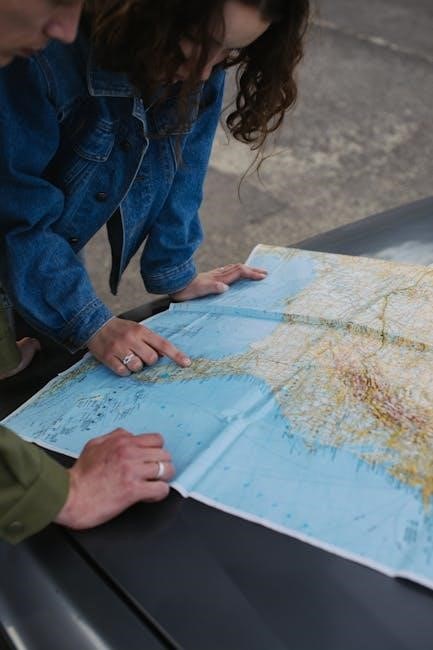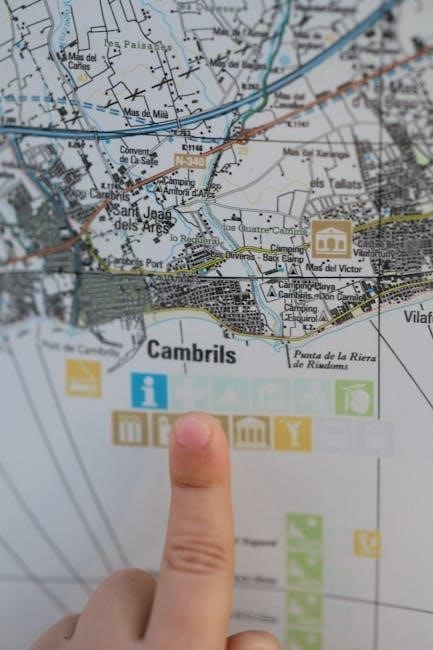Paul’s missionary journeys were pivotal in spreading Christianity, covering regions like Cyprus, Galatia, Macedonia, and Achaia. Mapping these travels provides a visual guide to his historic routes, challenges, and enduring legacy, illustrating the spread of Christianity across the Mediterranean world.
Overview of Paul’s Missionary Travels
Paul’s missionary travels spanned four major journeys, covering regions like Cyprus, Galatia, Macedonia, Achaia, Ephesus, Corinth, Rome, and Spain. These journeys, documented in Acts and his epistles, focused on spreading Christianity, establishing churches, and strengthening existing ones. The Paul’s Missionary Journey Map PDF visualizes his routes, highlighting key cities and challenges, such as persecution and cultural conflicts. This tool provides a clear understanding of Paul’s extensive travels, showcasing his resilience and the profound impact of his ministry on the early Christian church and its global expansion.
The Importance of Mapping Paul’s Journeys
Mapping Paul’s missionary journeys provides a visual and historical context, tracing his travels across the Mediterranean. It highlights key locations, such as Cyprus, Galatia, and Corinth, where he established churches. The Paul’s Missionary Journey Map PDF helps visualize the spread of Christianity, offering insights into cultural and religious challenges. This tool enhances biblical study by illustrating Paul’s resilience and the strategic expansion of his ministry. It bridges geography and theology, making his journeys relatable and understandable for modern audiences while preserving the legacy of early Christianity.
Historical Context of Paul’s Ministry
Paul’s missionary journeys occurred in the 1st-century Mediterranean world, a time of cultural and religious diversity. His ministry emerged amid the early Christian church’s expansion beyond Jerusalem. Paul, a former Pharisee, became a pivotal figure in spreading Christianity to Gentiles, breaking from traditional Jewish practices. His travels across Cyprus, Galatia, Macedonia, and Achaia marked a shift toward inclusive evangelism. The historical context underscores the challenges of navigating Jewish and Gentile relations, Roman governance, and cultural barriers. Paul’s journeys laid the foundation for early Christian communities, shaping the faith’s global spread and theological development.
Paul’s First Missionary Journey
Paul’s first journey, detailed in Acts 13-14, began in Antioch, focusing on Cyprus, Lycia, and Galatia. Key cities included Salamis, Paphos, and Antioch of Pisidia. Despite persecution, he established churches and spread Christianity, laying the foundation for future missions.
Route and Key Locations
Paul’s first missionary journey began in Antioch, Syria, and extended through Cyprus, Lycia, and Galatia. Key stops included Salamis, Paphos, Perga, Antioch of Pisidia, Iconium, Lystra, and Derbe. In Cyprus, Paul and Barnabas preached in synagogues, converting Sergius Paulus, a Roman governor. Moving to Asia Minor, they faced persecution but established thriving churches. The journey concluded with their return to Antioch, marking the successful spread of Christianity to Gentiles and laying the groundwork for future missionary efforts across the Mediterranean world.
Significance of Cyprus, Lycia, and Galatia
Cyprus, Lycia, and Galatia were pivotal in Paul’s first missionary journey, marking the beginning of Gentile evangelism. Cyprus, where Sergius Paulus converted, symbolized the gospel’s expansion beyond Jewish communities. Lycia and Galatia, despite persecution, saw thriving churches established, showcasing early Christianity’s resilience. These regions represented a strategic shift from Jewish-centric ministry to inclusive Gentile-focused outreach, highlighting the universal nature of the gospel. Their significance lies in demonstrating Paul’s adaptability and the transformative power of his message, which laid the foundation for future missionary efforts across the Mediterranean world.
Challenges and Successes in the First Journey

Paul’s first missionary journey faced significant challenges, including persecution and expulsion from cities like Iconium and Lystra. Despite being stoned in Lystra, Paul persevered, demonstrating unwavering faith. The journey also saw remarkable successes, such as the conversion of Sergius Paulus in Cyprus, marking a pivotal moment in Gentile evangelism. Churches were established in Lycia and Galatia, laying a strong foundation for future missionary efforts. These achievements underscored Paul’s resilience and the transformative power of his message, which resonated across diverse cultures and solidified the spread of Christianity beyond Jerusalem.
Paul’s Second Missionary Journey
Paul’s second journey expanded his ministry, guided by the Holy Spirit, to Macedonia and Achaia, preaching in Philippi, Thessalonica, and Corinth, and returning to Antioch.
Expansion into Macedonia and Achaia
Paul’s second missionary journey marked a significant expansion into Macedonia and Achaia, driven by a divine vision. Guided by the Holy Spirit, he traveled to Philippi, Thessalonica, Berea, and Corinth, preaching the Gospel to both Jews and Gentiles. Despite facing persecution, Paul established thriving churches in these regions, laying a strong foundation for Christianity. His ministry in Corinth was particularly impactful, resulting in a vibrant Christian community. This journey showcased Paul’s obedience to God’s call and his determination to spread the Gospel across the Mediterranean world, leaving a lasting legacy in these regions.
Key Cities: Philippi, Thessalonica, and Corinth
Philippi, Thessalonica, and Corinth were pivotal cities during Paul’s second missionary journey. In Philippi, Paul and Silas faced imprisonment but led the jailer and his household to faith. Thessalonica saw the establishment of a resilient church despite Jewish opposition. Corinth became a hub for extensive ministry, where Paul spent 18 months preaching and writing influential epistles. These cities represented key milestones in Paul’s mission, showcasing his ability to adapt to diverse cultures and perseverance amid persecution, ultimately fostering vibrant Christian communities that endured for centuries.
Ministry Impact and Persecution
Paul’s second missionary journey was marked by significant ministry impact and intense persecution. In Philippi, he and Silas were imprisoned but led the jailer and his household to faith. In Thessalonica, they faced fierce Jewish opposition but established a resilient church. Corinth became a hub for extensive ministry, where Paul spent 18 months preaching and writing influential epistles. Despite repeated persecution, Paul’s unwavering faith and bold preaching transformed lives, fostering vibrant Christian communities that endured for centuries, leaving a lasting legacy in the regions he visited.

Paul’s Third Missionary Journey
Paul’s third journey focused on strengthening churches in Asia Minor and Greece, with extended ministry in Ephesus and Corinth. Despite persecution, his teachings solidified Christianity’s roots.
Focusing on Ephesus and Corinth
During his third journey, Paul concentrated on Ephesus and Corinth, spending extensive time in these cities. In Ephesus, he preached boldly, establishing a strong church that became a hub for Asian ministry. Corinth, a bustling trade center, was another focal point, where he addressed theological and moral issues through his epistles. These cities were crucial for spreading Christianity, showcasing Paul’s strategic approach to evangelism and his ability to adapt to diverse cultural contexts, leaving a lasting impact on early Christian communities.
Strengthening Churches in Asia Minor
Paul’s third journey focused on reinforcing churches in Asia Minor, particularly in Galatia and Phrygia. He revisited these regions to ensure the spiritual growth and stability of the early Christian communities. By preaching and teaching, he addressed theological and practical issues, deepening the believers’ understanding of the faith. The map PDF highlights his routes through these areas, showcasing his commitment to nurturing the churches he had previously established. This phase of his ministry was crucial for the long-term survival and expansion of Christianity in the region.
Persecution and Resilience
Paul faced intense persecution throughout his missionary journeys, including beatings, imprisonment, and constant opposition. Despite being stoned in Lystra, jailed in Philippi, and enduring hardships, he remained steadfast in his faith. The map PDF illustrates the regions where he encountered severe challenges, such as Galatia and Macedonia. Paul’s resilience transformed these trials into opportunities to spread the Gospel, even preaching in prison. His unwavering commitment to Christ, despite suffering, became a testament to his devotion and the power of the Gospel, inspiring future generations of believers.

Paul’s Fourth Missionary Journey
Paul’s fourth journey, hinted at in his epistles, likely included Rome and Spain, spreading Christianity further. The map PDF illustrates his extensive travels, highlighting key destinations and challenges faced during this final missionary effort, which solidified his legacy in early Christianity.
Journey to Rome and Beyond
Paul’s fourth missionary journey, as depicted in the map PDF, began in Jerusalem and led to Rome, where he was imprisoned for two years. During this time, he continued to preach, reaching Roman believers and high-ranking officials. The map highlights his route, including key cities like Rome and Puteoli, where he shared the Gospel. This journey marked the culmination of his missionary efforts, spreading Christianity to new regions. The map serves as a visual guide, illustrating the extensive travels and challenges Paul faced, while emphasizing his unwavering dedication to his mission.
Ministry in Spain and Its Significance
Paul’s journey to Spain, as hinted in his epistles, marked a significant expansion of Christianity into Western regions. The map PDF highlights this pivotal mission, showcasing his efforts to spread the Gospel beyond Rome. Spain’s diverse culture and strategic location made it a crucial destination for evangelism. Paul’s ministry there, though not detailed in Acts, is inferred from his letters, emphasizing the universal reach of his teachings. This journey underscored his vision for a global Christian community, leaving a lasting legacy in the spread of Christianity.
Legacy of the Fourth Journey
Paul’s fourth missionary journey left a lasting legacy, particularly through his imprisonment in Rome, where he shared the Gospel with Roman believers. His subsequent travels to Spain further expanded Christianity’s reach. The letters he wrote during this period, such as those to the Romans and others, became foundational to Christian doctrine; The map PDF illustrates his extensive missionary efforts, highlighting key destinations and challenges. This journey solidified his impact on early Christianity, making the map a vital tool for understanding his enduring influence and the spread of the faith.
Challenges Faced During the Journeys
Paul faced persecution, imprisonment, and cultural conflicts, enduring hardships like shipwrecks and beatings. These challenges, detailed in the map PDF, highlight his resilience and unwavering faith.

Persecution and Imprisonment
Paul endured intense persecution and imprisonment throughout his missionary journeys. He was beaten in Philippi, imprisoned in Jerusalem, and placed under house arrest in Rome. Despite these hardships, he continued to preach, using even his imprisonment as an opportunity to share the Gospel. The map PDF highlights these events, showing how persecution did not deter Paul but instead became a testament to his unwavering faith and commitment to spreading Christianity. His resilience in the face of adversity remains a cornerstone of his legacy.
Cultural and Religious Conflicts
Paul faced significant cultural and religious conflicts during his journeys, particularly in regions like Lystra and Corinth. In Lystra, he was worshipped as a god before being stoned, while in Corinth, Jewish opposition led to Gentile-focused ministry. The map PDF illustrates these tensions, showing how Paul navigated diverse cultural landscapes to preach the Gospel. These conflicts underscored the challenges of spreading Christianity in a predominantly pagan and Jewish world, yet they also highlighted Paul’s adaptability and determination to share his message across cultural divides.

Overcoming Adversity
Paul’s missionary journeys were marked by remarkable resilience in the face of adversity. Despite imprisonment, beatings, and persecution, he remained steadfast in his mission. The map PDF highlights his perseverance, showing how he continued to preach even after being stoned in Lystra or imprisoned in Philippi. Paul’s ability to overcome adversity became a testament to his faith, inspiring early Christian communities to endure hardships. His unwavering commitment to spreading the Gospel transformed challenges into opportunities, leaving a lasting legacy of resilience and devotion.

The Legacy of Paul’s Missionary Journeys
Paul’s journeys established early Christian churches, shaped doctrine, and inspired global outreach. His teachings and resilience left a lasting impact, making him a cornerstone of Christianity’s spread and legacy.

Establishment of Early Christian Churches
Paul’s missionary journeys led to the founding of numerous early Christian churches across the Mediterranean. From Cyprus to Galatia, Macedonia, and Achaia, he preached the Gospel, converting both Jews and Gentiles. These churches became vital centers for spreading Christianity, fostering community, and preserving doctrine. The Paul’s Missionary Journey Map PDF vividly illustrates the locations and routes, providing a visual timeline of how Paul’s efforts established a network of believers. This foundational work laid the groundwork for the global expansion of Christianity, making his journeys historically and spiritually pivotal.
Influence on Christian Doctrine
Paul’s missionary journeys profoundly shaped Christian doctrine through his epistles and teachings. His letters to Corinth, Galatia, and others addressed theological issues, moral guidance, and church unity. He emphasized salvation through faith in Christ, the unity of believers, and the transformative power of grace. The Paul’s Missionary Journey Map PDF highlights the regions where these doctrines were first shared, illustrating how his travels disseminated core Christian teachings. His writings remain foundational to Christian theology, guiding believers on ethics, faith, and the nature of God, ensuring his influence endures across centuries.
Enduring Impact on Global Christianity
Paul’s missionary journeys had a profound and lasting impact on global Christianity, establishing churches and spreading the Gospel across the Mediterranean. His teachings on grace, faith, and church unity remain foundational to Christian doctrine. The Paul’s Missionary Journey Map PDF visually traces his travels, showcasing how his efforts led to the widespread dissemination of Christianity. His legacy continues to inspire modern missionaries and scholars, underscoring the importance of his work in shaping the global Christian community. His influence endures as a testament to the transformative power of his ministry.
Using the Paul’s Missionary Journey Map PDF
The Paul’s Missionary Journey Map PDF provides a detailed visual guide to Paul’s travels, highlighting key locations and routes. It aids in understanding the spread of Christianity, making his journeys more accessible for study and reflection.
Visualizing the Spread of Christianity
The Paul’s Missionary Journey Map PDF offers a visual representation of Paul’s travels, tracing his routes across Cyprus, Galatia, Macedonia, and Achaia. By highlighting key cities like Corinth and Ephesus, the map illustrates how Christianity expanded from Jerusalem to the Mediterranean world. This tool helps users understand the historical and cultural contexts of Paul’s ministry, making his journeys more accessible for study and reflection. It also underscores the challenges he faced, such as persecution, while emphasizing the resilience and impact of his missionary efforts in spreading the Gospel.

Key Features of the Map
The Paul’s Missionary Journey Map PDF includes detailed routes, key locations, and descriptions of Paul’s travels. It highlights cities like Corinth and Ephesus, providing historical context for his ministry. The map is available as a free download, making it accessible for Bible study and educational purposes. It also features visual representations of his journeys, helping users trace the spread of Christianity. This tool is invaluable for understanding the geographical and cultural aspects of Paul’s missionary work, offering a comprehensive overview of his impact on early Christianity.
Enhancing Biblical Study with the Map
The Paul’s Missionary Journey Map PDF serves as a powerful tool for enhancing biblical study by visualizing Paul’s travels. It connects scripture with geography, making the narrative more engaging and accessible. The map details key locations, such as Corinth and Ephesus, and traces the spread of Christianity. This resource helps students and scholars alike understand the historical and cultural context of Paul’s ministry. By providing a visual representation of his journeys, the map deepens the understanding of his missionary impact and the growth of the early Christian church.
Paul’s missionary journeys, vividly illustrated by the Paul’s Missionary Journey Map PDF, highlight his transformative impact on early Christianity. His travels and teachings continue to inspire and guide believers globally, showcasing the enduring legacy of his ministry and the spread of the Gospel across the Mediterranean world.

Paul’s missionary journeys, as illustrated in the Paul’s Missionary Journey Map PDF, had a profound impact on early Christianity. He established churches across Cyprus, Galatia, Macedonia, and Achaia, spreading the Gospel to both Jews and Gentiles. His teachings emphasized faith, grace, and unity, shaping Christian doctrine. Despite facing persecution and imprisonment, Paul’s resilience and divine guidance enabled him to overcome adversity, leaving a lasting legacy. His letters, written during these travels, remain foundational for Christian theology, inspiring believers worldwide and demonstrating the transformative power of his ministry.
The Value of Mapping Historical Journeys
Mapping Paul’s missionary journeys, as seen in the Paul’s Missionary Journey Map PDF, provides a visual and chronological understanding of his travels. It highlights key locations, routes, and the spread of Christianity, offering insights into the historical and cultural contexts of his ministry. This tool aids in tracing the development of early Christian communities and the challenges Paul faced. By visualizing his journeys, readers gain a deeper appreciation of his resilience and the enduring impact of his work, making it an invaluable resource for biblical study and inspiration.



